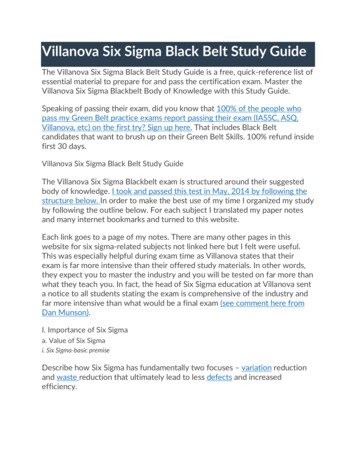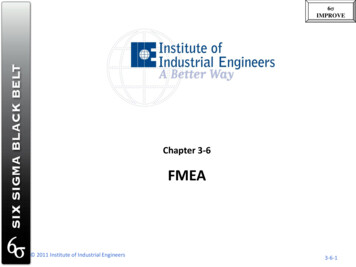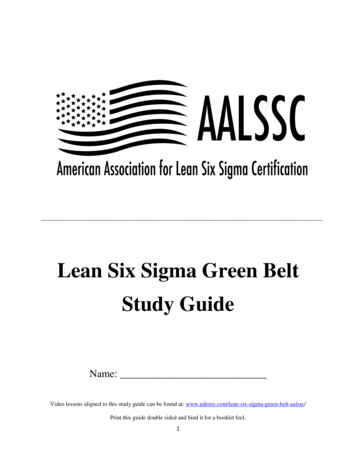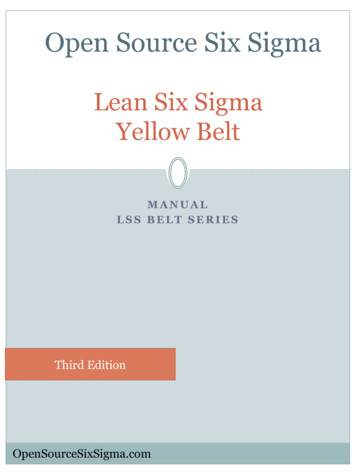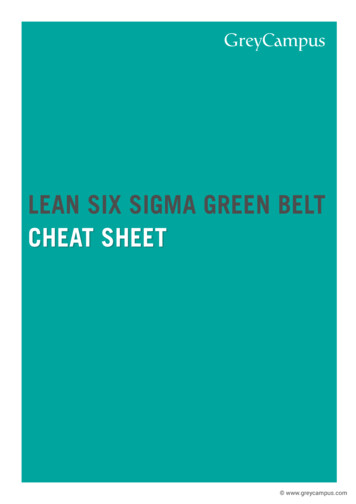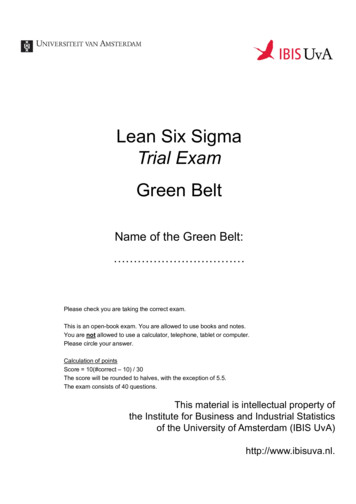
Transcription
GreyCampusLEAN SIX SIGMA BLACK BELTCHEAT SHEET www.greycampus.com
2Includes formulas: what they are, when to use them, referencesCONTENTSANOVADOE (DESIGN OF EXPERIMENTS) One Factor At a Time thogonalityFactorial experimentsStep-by-step procedureREGRESSION Linear RegressionNon-Linear RegressionOLS (Ordinary Least Squares)NON-NORMAL DISTRIBUTIONS with respect to (wrt) Confidence Intervalswrt Gage R&Rwrt T-testwrt ANOVAwrt Pearson Correlation Coefficientwrt Central Limit Theoremwrt Control Chartswrt Control Limitswrt Process Capabilitywrt Control Planswrt Design Of Experimentswrt RegressionVARIANCE INFLATION FACTORLIFE TESTING & RELIABILITY AQL (Acceptable Quality Limit)AOQL (Average Outgoing Quality Limit)QFD (QUALITY FUNCTION DEPLOYMENT) Critical to Quality Characteristics (CTQ)House of Quality (HOQ) www.greycampus.com
3ANOVAAnova Used for hypothesis testing when comparing multiple groups.Hypothesis takes the form Ho: µ1 µ2 µ3 In its simplest form ANOVA gives a statistical test of whether the means ofseveral groups are all equal, and therefore generalizes Student’s two-samplet-test to more than two groups.It is a collection of statistical models, and their associated procedures, inwhich the observed variance is partitioned into components due to differentexplanatory variables.DOE DESIGN OF EXPERIMENTS Design of Experiments is using statistical tools (such as ANOVA above andregression below) to be able to determine the importance of different factorswith a minimal amount of data. It is used when you have many differentfactors that may impact results (i.e.: many x’s that impact Y in the classicY f(x) formula).By collecting the data, organizing it, and analyzing it using DoE methodology you do not have to study One Factor At a Time (OFAT) to isolate whichfactors have the biggest impact.DoE’s are best carried out using software specifically designed for DoE (suchas Minitab or JMP).Most important ideas of experimental design:Comparison In many fields of study it is hard to reproduce measured results exactly. Comparisons between treatments are much more reproducible and are usuallypreferable. Often one compares against a standard or traditional treatmentthat acts as baseline.Randomization There is an extensive body of mathematical theory that explores the consequences of making the allocation of units to treatments by means of somerandom mechanism such as tables of random numbers, or the use of randomization devices such as playing cards or dice. Provided the sample size isadequate, the risks associated with random allocation (such as failing to obtain a representative sample in a survey, or having a serious imbalance in akey characteristic between a treatment group and a control group) are calculable and hence can be managed down to an acceptable level. Random doesnot mean haphazard, and great care must be taken that appropriate randommethods are used.Replication Measurements are usually subject to variation, both between repeated measurements and between replicated items or processes. www.greycampus.com
4Blocking Blocking is the arrangement of experimental units into groups (blocks) thatare similar to one another. Blocking reduces known but irrelevant sources ofvariation between units and thus allows greater precision in the estimationof the source of variation under study.Orthogonality Orthogonality concerns the forms of comparison (contrasts) that can belegitimately and efficiently carried out. Contrasts can be represented byvectors and sets of orthogonal contrasts are uncorrelated and independentlydistributed if the data are normal. Because of this independence, each orthogonal treatment provides different information to the others. If there areT treatments and T – 1 orthogonal contrasts, all the information that can becaptured from the experiment is obtainable from the set of contrasts.Factorial experiments Use of factorial experiments instead of the one-factor-at-a-time method.These are efficient at evaluating the effects and possible interactions of several factors (independent variables).Step-by-step procedure In effective design of an experiment. (Note this is taken from the link above;not every step may be needed for your experiment. Software packages oftenhave tutorials showing how to do a DoE specifically with their application.) Select the problem Determine dependent variable(s) Determine independent variables Determine number of levels of independent variables Determine possible combinations Determine number of observations Redesign Randomize Meet ethical & legal requirements Develop Mathematical Model Collect Data Reduce Data Verify DataREGRESSIONLinear Regression Linear regression attempts to use a straight line to determine a formula for avariable (y) from one or more factors (Xs).This is best done using a software package such as excel, Minitab, or JMP. www.greycampus.com
5 Linear regression has many practical uses. Most applications of linear regression fall into one of the following two broad categories: If the goal is prediction, or forecasting, linear regression can be used tofit a predictive model to an observed data set of y and X values. Afterdeveloping such a model, if an additional value of X is then given without its accompanying value of y, the fitted model can be used to make aprediction of the value of y. If we have a variable y and a number of variables X1, ., Xp that maybe related to y, we can use linear regression analysis to quantify thestrength of the relationship between y and the Xj, to assess which Xj mayhave no relationship with y at all, and to identify which subsets of theXj contain redundant information about y, so that once one of them isknown, the others are no longer informative.Linear regression models are often fit using the least squares approach, butmay also be fit in other ways, such as by minimizing the “lack of fit” in someother norm, or by minimizing a penalized version of the least squares lossfunction as in ridge regression. Conversely, the least squares approach canbe used to fit models that are not linear models. Thus, while the terms “leastsquares” and linear model are closely linked, they are not synonymous.Non-Linear Regression Non-linear regression attempts to determine a formula for a variable (y) fromone or more factors (Xs), but it differs from linear regression because it allows the relationship to be something other than a straight line.This is best done using a software package such as an excel add-on, Minitab,or JMP.examples of nonlinear functions include exponential functions, logarithmicfunctions, trigonometric functions, power functions, Gaussian function, andLorentzian curves. Some functions, such as the exponential or logarithmicfunctions, can be transformed so that they are linear. When so transformed,standard linear regression can be performed but must be applied with caution: Some nonlinear regression problems can be moved to a linear domain bya suitable transformation of the model formulation. For example, consider the nonlinear regression problem (ignoringthe error): y aebx. If we take a logarithm of both sides, it becomes: ln (y) ln (a) bx. Therefore, estimation of the unknown parameters by a linear regression of ln(y) on x, a computation that does not require iterative optimization. However, use of a linear transformation requirescaution. The influences of the data values will change, as will theerror structure of the model and the interpretation of any inferential results. These may not be desired effects. On the other hand,depending on what the largest source of error is, a linear transformation may distribute your errors in a normal fashion, so thechoice to perform a linear transformation must be informed bymodeling considerations.
6 In general, there is no closed-form expression for the best-fitting parameters,as there is in linear regression. Usually numerical optimization algorithmsare applied to determine the best-fitting parameters.The best-fit curve is often assumed to be that which minimizes the sum ofsquared residuals. This is the (ordinary) least squares (OLS) approach. However, in cases where the dependent variable does not have constant variancea sum of weighted squared residuals may be minimized; see weighted leastsquares. Each weight should ideally be equal to the reciprocal of the varianceof the observation, but weights may be recomputed on each iteration, in aniteratively weighted least squares algorithm.NON - NORMAL DISTRIBUTIONS There are as many different distributions as there are populations. Demingsaid ‘there a no perfect models, but there are useful models’. That’s the question you need to ask relative to your problem: What tools & techniques willwork well with the distribution for the population I have?Cycle time data can not go below zero, and therefore is never truly normal.It invariably has a longer tail to the right than to the left.Often times when a population has non-normal data it can be stratified intosegments that have approximately normal distributions. And you can assume normality after you have determined these subpopulations and pulleddata from the subpopulations to test separately.When doing data analysis I would first determine if the data is normal. If itis not: Consider how important the distribution is to the tools you plan to use.Of the tools in this cheat sheet these ones are affected if the distributionis non-normal: Confidence Intervals: concept is the same, but you can not usethe 1.96 as the multiplier for a 95% CI. Gage R&R : In most real-world applications the impact of non-normal data on this tool is negligible. T-test : t-test assumes normality. Consider: If data is close to normal you may be safe using a t-test. Depending on other factors you may be able to use the Central Limit Theorem and normalize the data. You may prefer a hypothesis test that doesn’t assume normality such as the Tukey Test or Moods Median Test. ANOVA : ANOVA assumes normality. Consider: If data is close to normal you may be safe using ANOVA. Depending on other factors you may be able to use the Central Limit Theorem and normalize the data. You may prefer a hypothesis test that doesn’t assume normality such as Levene’s Test or Brown-Forsythe Test or the FmaxTest or the Friedman Test. www.greycampus.com
7 Pearson Correlation Co-efficient Pearson is usually considered accurate for even non-normaldata, but there are other tools that are specifically designedto handle outliers. These correlation coefficients generallyperform worse than Pearson’s if no outliers are present. Butin the event of many extreme outliers consider Chi-square,Point biserial correlation, Spearman’s p, Kendall’s T, or Goodman and Kruskal’s lambda. Central Limit Theorem can be used to transform data from anon-normal to a normal distribution. Control Charts, Control Limits, Process Capability, and ControlPlans. Standard Control Charts, Control Limits, and Process Capability metrics assume normality. Consider: If data is close to normal you may be safe using a standardcontrol chart. Depending on other factors you may be able to use the Central Limit Theorem and normalize the data. Your statistical package may allow for a test based on thedistribution you have. For example Minitab supports Weibulldistribution and will compute the capability six pack including the control charts for a Weibull distribution. You may use the transformation formulas to use a controlchart designed for non-normal data. UCL .99865 quantile Center line median LCL .00135 quantile This revision does affect out of control conditions aswell as process capability measurements. Design Of Experiments DOE assumes normal data. If data is close to normal you may be safe using DOE. Depending on other factors you may be able to use the Central Limit Theorem and normalize the data. Regression Generalized linear models (GLMs) are used to do regressionmodelling for non-normal data with a minimum of extracomplication compared with normal linear regression.1. The GLM consists of three elements.2. A distribution function f, from the exponential family.3. A linear predictor η Xβ .4. A link function g such that E(Y) μ g-1(η). The exact formulas depend on the underlying distribution. www.greycampus.com
8 Some of the more common non-normal distributions include Weibull, Exponential, Log-normal. Minitab’s distribution identity function can test for these distributions. NOTE: Weibull can benormal if 1 λ & k 5. Gamma, Poisson, Chi-squared, Beta, Bi-modal, Binomial, Student-t. (NOTE: Student-t is very close to normal but has a longertail).Some other distributions include Laplace, Logistic, Multinomial, Negative Binomial, Erlang, Maxwell-Boltzmann, Inverse-gamma, Dirichlet,Wishart, Cauchy, Snedecor F, Uniform, Bernoulli, Geometric, Hypergeometric, Triangular, Rectangular.VARIANCE INFLATION FACTOR (VIF) The VIF measures how much the interaction between independent variablesimpact the dependent variable. (I.e. going back to the Y f(x) equation howmuch do the different x’s interact with each other to determine Y.) Consider the following regression equation with k independent variables: Y β0 β1 X1 β2 X 2 . βk Xk ε VIF can be calculated in three steps: Calculate k different VIFs, one for each Xi by first running anordinary least square regression that has Xi as a function ofall the other explanatory variables in the first equation. If i 1, for example, the equation would be X1 α2 X 2 . αk Xk c0 ε where c0 is a constant and e is theerror term. Then, calculate the VIF factor for β with the following formula: VIF(β i) [1 /(1-R2i)] where R2iis the coefficient of determination of the regression equation in step one. Then, Analyze the magnitude of mul
distribution and will compute the capability six pack includ-ing the control charts for a Weibull distribution. You may use the transformation formulas to use a control chart designed for non-normal data. UCL .99865 quantile Center line median LCL .00135 quantile This File Size: 234KBPage Count: 11



